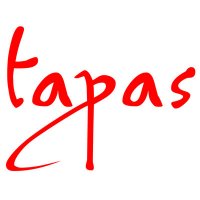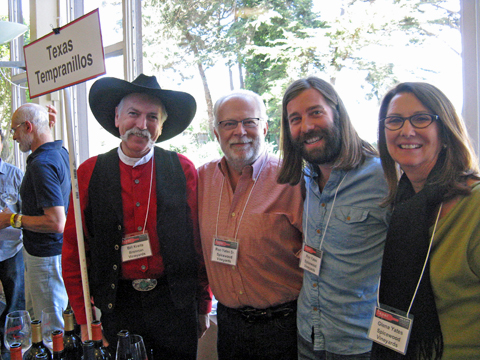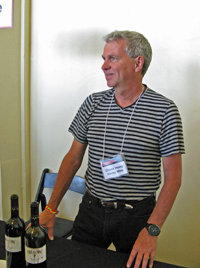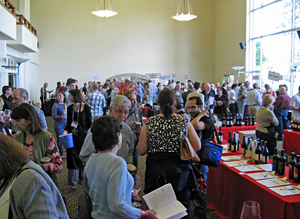Abacela Vineyards and Winery
Abacela 2012 Tempranillo, “Fiesta,” Umpqua Valley, Southern Oregon. Aged in 18% new oak, mostly French, and bottled under screwcap. Medium purple color, with upfront ripe plum fruit plus tobacco, spice, and smoke aromas. Medium-bodied with good structure and moderately grippy tannins – made for early drinking but this could hold up to some time in the cellar too, nice.
Comments: Earl and Hilda Jones planted the first Tempranillo in the Pacific Northwest in 1995, and have been leaders among wineries making wine from Iberian grape varieties ever since. Earl was one of the founders of TAPAS and its first president. I got to the Abacela table late in the afternoon, and unfortunately for me, Earl had poured out of most of his wines by then. I did get to try their “Fiesta” bottling – intended to have more upfront fruit and immediate appeal than their more “serious” Tempranillos – and the 2012 was the best of the early-drinking Abacela Tempranillos I’ve tasted yet.
Bending Branch Winery
Bending Branch 2012 Tempranillo, Newsom Vineyards, Texas High Plains. Aged for 24 months in American oak. Medium purple, with upfront ripe plum and blueberry fruit, vanilla/oak, and spice. Medium-bodied with a firm tannic finish.
Comments:
Founded by Dr. Robert Young near Comfort, Texas, the estate vineyard was planted in 2008 and the winery opened in 2010. There are currently 16 grape varieties planted on 20 acres, with Tannat being a particular specialty. Dr. Young makes the wine, and runs the winery along with son-in-law John Rivenburgh.
Berryessa Gap Vineyards
Berryessa Gap 2014 Albariño, Yolo County. Light straw color, this featured bright citrus fruit, fresh herbs, and a hint of flowers. Medium-light bodied with a lively mouthfeel and chalky note on the crisp finish, nice.
Berryessa Gap 2014 Verdelho, Yolo County. Light straw color, with pear and stone fruit, spice, and lemonpeel notes. Medium weight with a smoother texture and finish than the previous wine.
Berryessa Gap 2014 Verdejo, Yolo County. Light straw color, showing an earthier profile, plus stone fruit and herbs. Medium-bodied with a fairly smooth mouthfeel and finish.
Comments: Berryessa Gap grew from the 1969 partnership of farmer Dan Martinez, Sr. and winemaker Ernest Peninou to develop a grapevine rootstock nursery business. In 2000, Dan Martinez, Jr. partnered with Santiago Moreno to purchase Coble Ranch and plant a vineyard there. Berryessa Gap launched their winery in 2002, and in 2013 Nicole Salengo became their winemaker.
Bokisch Vineyards
Bokisch 2014 Verdejo, Clay Station Vineyard, Borden Ranch-Lodi. 100% Verdejo, made entirely in stainless steel. Very light straw color, featuring bright apple and pear fruit, flowers, and touches of lemonpeel and fresh herbs. Medium-light bodied with a vibrant texture and crisp finish, nice.
Bokisch 2014 Verdelho, Vista Luna Vineyard, Borden Ranch-Lodi. 95% Verdelho, 5% Verdejo, made entirely in stainless steel. Very light straw color, this showed stone fruit and tropical fruit on the nose, with spice and a hint of flowers. A bit richer on the palate than the previous wine, with a smooth finish.
Bokisch 2014 Albariño, Terra Alta Vineyard, Clements Hills-Lodi. 100% Albariño, made entirely in stainless steel. Very light straw color, with pear, herbs, and earth aromas. Medium weight with a lively mouthfeel and long finish.
Comments: Markus and Liz Bokisch established Bokisch Ranches in the Lodi area in 1996, and produced their first wines in 2001. One of California’s leaders among wineries specializing in Iberian grape varieties, the Bokisch Ranch vineyards in the Lodi area are all farmed organically. I had tasted a number of Bokisch current wines recently – including all the 2012 reds poured at the event – so I stuck with these brand-new releases of whites, all of which were very good. Of the reds I tasted not long ago, the Garnacha, Graciano, and Monastrell were my favorites.
Brennan Vineyards
Brennan 2012 Tempranillo, Texas. Medium purple color, displaying lots of spice along with earth, ripe dark fruits, and sweet oak. Medium-bodied and structured, finishing with fairly grippy tannins.
Brennan 2013 Tempranillo, “Reserve,” Texas. Medium purple, this showed a curious nutty character along with earth, spice, and vanilla/oak aromas. Medium-full bodied, with big but refined tannins on the finish.
Comments: Founded by Pat Brennan in 2001, the estate vineyard was planted the following year near Comanche, near the junction of the Texas Hill Country and High Plains growing areas. The winery grows 10 grape varieties on 30 acres of estate vineyard land. They also produce wines under the Austin Street label. Todd Webster is the Brennan winemaker, and Bill Kreitz was on hand at the tasting.
Caduceus Cellars
Merkin 2013 “Shinola Bianca,” New Mexico. 92% Malvasia and 8% Moscato from Luna Rosa Vineyard, fermented partly in stainless steel and partly in puncheons. Light straw color, this showed upfront floral aromas along with pear and stone fruit. Medium-light bodied with moderate acidity and clean finish.
Caduceus 2012 “Dos Ladrones,” Graham County, Arizona. 50% each Malvasia Bianca and Chardonnay from Bonita Springs Vineyard, whole-cluster pressed and co-fermented, aged in stainless steel and neutral oak. Medium-light color, with floral notes along with spice, stone fruit, and a background of vanilla/oak. Medium weight with a richer mouthfeel and smoother finish.
Caduceus 2012 “Sancha,” Cochise County, Arizona. 97% Tempranillo and 3% Malbec from Buhl Memorial Vineyard, aged in new and neutral French oak. Medium-dark purple, with bright black cherry, spice, earth, and leather along with dried herbs and a touch of sweet oak. Moderately rich on the palate with plenty of structure and firm tannins, nice now and should develop well in the cellar.
Merkin 2013 “Tarzan,” New Mexico. 88% Tempranillo and 12% Primitivo from Luna Rosa Vineyard, aged in new and neutral French oak. Medium-dark color, with leather, spice, plum, and smoke on the nose. Big and bold, finishing with grippy tannins.
Comments: Caduceus is located in the Verde Valley in central Arizona, though fruit is sourced from various locations. Owner/winemaker Maynard James Keenan (he’s also a famed rock vocalist, best-known for his work with the band Tool) produced his first wines from the 2004 vintage. Merkin Vineyards is the winery’s second label, with fruit sourced from 4,300-foot elevation Luna Rosa Vineyard in Luna County, New Mexico. Belying the perception of wines from these states, the higher-elevation vineyards and attention to viticulture resulted in wines that were all under 14% alcohol.
Cholame Vineyard
Cholame 2014 Rosé, Central Coast. Made from 50% each Grenache and Albariño. Light pink-salmon color, displaying strawberry and watermelon aromas along with hints of fresh herbs. Medium-light weight with a fairly smooth texture and finish.
Cholame 2013 Grenache Blanc, “Summer Shade,” Santa Barbara County. Sourced from La Presa Vineyard in Santa Ynez Valley. Light straw color, with apple and stone fruit, spice, and touches of flowers and petrol on the nose. Medium-light bodied with a lively mouthfeel and clean finish, nice.
Cholame 2011 Tempranillo, “Bull Pen,” Monterey County. Medium purple color, this showed lots of tobacco and smoke along with black cherry, earth, and a touch of sweet oak. Medium-bodied with good structure, finishing with firm tannins – shows potential but could use more time in the cellar.
Comments: Cholame proprietor David DuBois launched the winery with the 2010 vintage, after planting 10 acres of vines near the small and isolated Monterey County town of Parkfield – better-known for its earthquakes than for vineyards. David planted Zinfandel, Grenache, Mourvèdre, Syrah, Petite Sirah and Tempranillo. He also works with white varieties from La Presa Vineyard in Santa Ynez Valley, which is managed by Cholame winemaker Andres Ibarra, a longtime winemaking veteran in Santa Barbara County. David was behind the table pouring his wines at the TAPAS event.
Cinder Wines
Cinder 2012 Tempranillo, Snake River Valley, Idaho. Sourced from two vineyards, aged in 40% new French and Hungarian oak. Medium purple color, with upfront ripe plummy fruit, smoke, dried herbs, and spice on the nose. Medium weight on the palate, finishing with moderate tannins.
Cinder 2013 Tempranillo, “Reserve,” Snake River Valley, Idaho. Sourced from two vineyards, aged in 20% new and 40% second-year French and Hungarian oak. Medium purple, this showed similar character to the previous wine with more smoke, spice, and sweet oak notes. A bit bigger and more structured on the palate, this had a firm tannic finish.
Comments: Winemaker Melanie Krause and her husband Joe Schnerr established Cinder Wines with the 2006 vintage, and the winery has received a number of accolades since then. Known mainly for their Rhône-variety wines and Tempranillo, they also make Chardonnay and a Bordeaux-style red blend. Cinder sources their fruit from a number of Snake River Valley growers. The winery name refers to the volcanic soil that is common to the region.
Core Wine Company
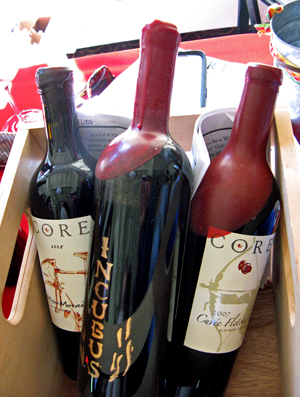 |
Core 2010 Carignane, Contra Costa County. Medium purple color, displaying bright black cherry fruit, earth, a touch of pepper, and vanilla/oak in the background. Medium-bodied with a lively mouthfeel and a stony mineral note on the finish, nice.
Core 2007 “Cuvée Fletcher,” Alta Mesa Vineyard, Santa Barbara County. 89% Grenache, 11% Mourvèdre. Medium purple, with higher-toned red fruit, pepper, and spice on the nose. Medium-bodied with moderate, chalky tannins.
Core 2010 “Elevation Sensation,” California. 59% Grenache, 23% Carignane, 11% Syrah, 7% Mourvèdre, with most of the Grenache and Mourvèdre from Alta Mesa Vineyard. Medium color, this had black cherry and plum fruit, earth, dried herbs, with touches of black pepper and sweet oak. Medium weight on the palate with good structure and firm tannins – needs some time in the cellar but has potential.
Core 2008 “Mister Moreved,” Alta Mesa Vineyard, Santa Barbara County. 94% Mourvèdre, 6% Grenache. Medium purple, showing higher-toned red fruit, earth, and notes of smoke and spice. Bolder mouthfeel with a chewy tannic finish.
Comments: Dave and Becky Corey launched their winery in 2001, and have expanded with several other labels since then. Alta Mesa Vineyard – which Dave used to farm – is located at over 3,000-foot elevation in far-eastern Santa Barbara County. Dave has been working with longer barrel-aging for the reds in recent years, and he’s been going farther from his Santa Maria base for vineyard sources too, such as with the old-vine Carignane from Contra Costa, a favorite of mine at the tasting. As usual, Dave was behind the Core table for the TAPAS event.
Dancing Coyote Wines
Dancing Coyote 2013 Albariño, Estate, Clarksburg. Made entirely in stainless steel with no malolactic fermentation. Very light straw color, with bright green apple on the nose along with lemonpeel and spice. Medium-light weight on the palate with crisp acidity and a clean finish, nice.
Dancing Coyote 2012 Tempranillo, Lodi. Medium purple color, displaying aromas of dried herb/tobacco, spice, blueberry and darker fruit, and earth. Moderately rich texture with a firm tannic finish.
Comments: Dancing Coyote was established in 2001, and has been pouring some very good wines – particularly whites – at TAPAS for a number of years. The Clarksburg region has proven to be a fine growing area for light and fresh white wines, as well as for some reds such as Petite Sirah. The Dancing Coyote whites are made entirely in stainless steel with no malolactic fermentation, and are all bottled under screwcap.
Dos Cabezas WineWorks
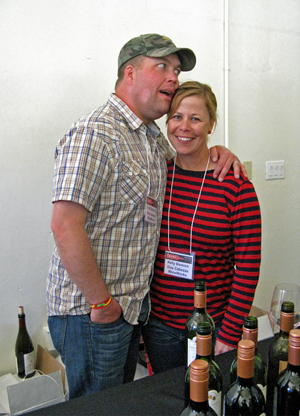 |
Dos Cabezas 2014 “Meskeoli,” Cimarron Vineyard, Cochise County, Arizona. 25% Viognier, 21% Roussanne, 19% Riesling, 17% Picpoul Blanc, 11% Malvasia, 6% Albariño, 1% Muscat, co-fermented with some skin contact. Light color, this featured bright stone fruit, flowers, and fresh herbs on the nose. Medium-light weight on the palate, this had a lively texture and crisp finish, nice.
Dos Cabezas 2014 “Pink,” Cimarron Vineyard, Cochise County, Arizona. 72% Garnacha, 21% Monastrell, 7% Syrah, farmed specifically for this wine. Very light salmon color, this had savory and spicy watermelon aromas. Medium-light bodied, with good acidity and slightly chalky texture on the finish.
Dos Cabezas 2011 “El Norte,” Cimarron Vineyard, Cochise County, Arizona. 47% Garnacha, 26% Monastrell, 22% Syrah, 4% Counoise. Medium purple, with ripe black cherry fruit plus spice and resiny oak. Medium-bodied with a fairly smooth mouthfeel and moderate tannins.
Dos Cabezas 2012 “Águileón,” Cimarron Vineyard, Cochise County, Arizona. 74% Tempranillo, 10% Garnacha, 8% Graciano, 8% Monastrell, aged for 24 months in new and older French and American oak. Medium purple color, displaying bright and spicy black cherry and plum fruit, spice, tobacco/dried herbs, and a touch of vanilla/oak. Medium weight with a firm tannic finish – shows promise but could use more time in the cellar.
Dos Cabezas 2012 “El Campo,” Pronghorn Vineyard, Sonoita, Arizona. Field blend composed mainly of Tempranillo and Monastrell, plus Petit Verdot, Petit Sirah, and Graciano, aged for 24 months in 100% new French oak. Medium-dark color, this showed riper dark fruit along with spice, pepper, and sweet oak. Big and structured, finishing with grippy tannins.
Comments: Dos Cabezas, established in 1995 in southeastern Arizona, has been producing some notable wines for a number of years. Winemaker Todd Bostock and his family purchased the winery in 2006. Fruit comes from the winery’s Pronghorn Vineyard and from Cimarron Vineyard, owned by noted Oregon vintner Dick Erath. Todd and his wife Kelly were behind the Dos Cabezas table at the event, and poured a solid group of wines – the “Meskeoli” white was a particular standout.
Fenestra Winery
 |
Fenestra 2010 Tempranillo, Lodi. Sourced from Silvaspoons and Bokisch vineyards. Medium-light purple, this showed ripe black cherry fruit, dried herb/tobacco, and touches of smoke and sweet oak. Medium-bodied, this finished with moderate tannins.
Fenestra 2010 Tempranillo, Livermore Valley. Sourced from Wente Vineyard. Medium purple, with brighter aromas of black cherry and plum, spice, earth, and tobacco, with vanilla/oak in the background. Bigger and more structured than the previous wine, with firmer tannins on the finish.
Fenestra 2010 Touriga Nacional, Livermore Valley. Sourced from Wente Vineyard. Medium purple color, featuring an earthier and darker-fruited profile, plus spice, tobacco, and touches of black pepper and sweet oak. Medium-bodied with a lively texture and good structure, finishing with moderate tannins, nice.
Comments: Fenestra owner Lanny Replogle makes a wide variety of Iberian-variety wines, sourced from Lodi’s Silvaspoons and Bokisch vineyards and from Livermore Valley, and has been at the TAPAS tastings from the start. Lanny and his wife Fran founded Fenestra in 1976 in Livermore Valley and continue to run the winery today. Aaron Luna is the Fenestra winemaker. I got to the Fenestra table on the late side and only tasted a few of their offerings – I thought the Touriga Nacional was a particular standout.
Hovey Wine
Hovey 2013 Tempranillo, “Rolleri Cuvée,” Calaveras County. Medium purple color, featuring ripe and upfront plum and blueberry fruit, spice, and touches of earth and sweet oak. Medium weight on the palate, with a stony mineral note along with big but refined tannins on the finish.
Comments: Longtime Sierra Foothills winemaker Chuck Hovey and his wife Jan launched the Hovey label in 2007 and their first wine, a Chardonnay, was released the following year. Their tasting room in Murphys opened in 2012. Although the winery produces a number of varietal wines and blends, their signature wine is the Tempranillo from Rolleri Vineyard, located above Angels Camp. Chuck has made Tempranillo from this vineyard for about 15 years, and he was pouring his most recent vintage at the TAPAS tasting.
Longoria Wines
Longoria 2014 Albariño, Clover Creek Vineyard, Santa Ynez Valley. Whole-cluster pressed and made in stainless steel. Light straw color, this had bright pear and stone fruit aromas with a touch of fresh herbs. Medium-light weight with a lively texture and slightly briny note on the crisp finish, nice.
Longoria 2012 Tempranillo, Santa Ynez Valley. 90% Tempranillo from Clover Creek Vineyard and 5% each Syrah and Merlot from Alisos Vineyard, aged entirely in American oak, about 40% new. Medium purple, with upfront plum and black cherry plus spice, dried herbs, and vanilla/oak notes. Medium-bodied and structured, finishing with grippy tannins – this will need more time in the cellar.
Comments: Known as one of the pioneers of fine Santa Barbara County wine, Rick Longoria is better-known for Pinot Noir and other varieties but he has made excellent Albariño and Tempranillo over the past ten years. Sourced mainly from Clover Creek vineyard in the Los Olivos area of Santa Ynez Valley, these have been consistent standouts at TAPAS over the years, and the Albariño was a favorite this year.
Pedernales Cellars
Pedernales 2012 Tempranillo, Texas. Fruit sourced from both the High Plains and Hill Country. Medium purple color, showing bright black cherry fruit, spice, earth, with a background of sweet oak. Medium weight in the mouth with good structure and moderate tannins, nice.
Comments: Pedernales is located in Stonewall, and began with Larry and Jeanine Kuhlken’s vineyard, planted near Fredericksburg in the early 1990s. Their children, David and Julie, and their spouses established Pedernales in 2005. They focus on wines from Spanish and Rhône grape varieties, with Tempranillo being a specialty. David is the winemaker, and the winery sources from several vineyards in addition to the Kuhlken Estate Vineyard.
|
Pierce Ranch Vineyards
Pierce Ranch 2014 Albariño, San Antonio Valley. Made mostly in stainless steel along with some neutral oak. Light straw color, this showed pear, spice, and earth on the nose. Medium-light weight with a bright texture and clean finish.
Pierce Ranch 2014 Verdelho, San Antonio Valley. Light color, featuring tropical fruit, spice, and a bubblegum note. Medium-bodied with a smooth mouthfeel and finish.
Pierce Ranch 2014 Rosé, San Antonio Valley. Entirely from Tinta Cão. Light salmon-pink color, with spice and earth, plus red fruit and watermelon in support. Medium-light weight with a fairly round texture and smooth finish.
Pierce Ranch 2012 Tinta Cão, San Antonio Valley. Medium purple color, this displayed bright red fruit, dried herbs, earth, and sweet oak on the nose. Medium-bodied and lively, finishing with moderate tannins, nice.
Pierce Ranch 2012 Tempranillo, San Antonio Valley. Medium-dark color, aromas of ripe plum, earth, herbs, and vanilla/oak. Bigger and more structured than the previous wine, with grippier tannins on the finish.
Pierce Ranch 2012 Graciano, San Antonio Valley. 100% Graciano. Medium purple, showing an earthier profile, plus darker berry fruit and spice. Medium-full bodied, finishing with firm tannins.
Pierce Ranch 2012 Touriga, San Antonio Valley. From about 60% Touriga Nacional and 40% Touriga Franca. Medium-dark purple, with very floral aromas along with black cherry fruit, spice, earth, and dried herbs. Medium-full bodied with plenty of structure and big but refined tannins, nice.
Comments: First planted in 1999 by Bill and Gail Pierce, Pierce Ranch has become one of California’s top vineyards for Iberian grape varieties, and their own wines have been very solid over the years. All of the fruit comes from the family vineyard in the San Antonio Valley of southern Monterey County – there are over 20 varieties planted there on just over 30 acres. As usual Josh Pierce poured his wines at TAPAS.
Quinta Cruz
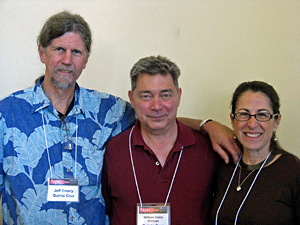 |
| Quinta Cruz - Jeff Emery, William Vieira Vroman, Cynthia Bournellis |
Quinta Cruz 2013 Albariño, Bokisch Vineyard, Clements Hills. Very light straw color, with spice, apple and stone fruit, and lightly floral scents. Lighter-bodied with bright acidity and a slightly chalky texture on the crisp finish, nice.
Quinta Cruz 2012 Verdelho, Silvaspoons Vineyard, Alta Mesa. Light color, showing less upfront fruit, with herbs and earth along with pear and a touch of spice. Medium-light bodied with a smoother texture and clean finish.
Quinta Cruz 2012 Tempranillo, Pierce Ranch, San Antonio Valley. 100% Tempranillo. Medium purple, this displayed bright black cherry, flowers, herbs, plus touches of black pepper and sweet oak. Medium weight with good structure, finishing with a stony mineral note and moderate tannins, nice.
Quinta Cruz 2010 Touriga, Pierce Ranch, San Antonio Valley. About 80% Touriga Nacional and 20% Touriga Franca. Medium-dark color, this had higher-toned plummy fruit along with earth, spice, and hints of flowers. Medium-bodied with firm tannins on the finish.
Quinta Cruz 2010 Souzão, Silvaspoons Vineyard, Alta Mesa. 100% Souzão. Dark purple, with a darker fruit profile plus earth, flowers, and lots of spice. Medium-full bodied with plenty of structure and grippier tannins.
Quinta Cruz 2011 Graciano, Bokisch Vineyard, Clements Hills. 100% Graciano. Medium-dark purple, featuring earth, spice, dark berry fruit, with touches of wet stones and pepper. Big but lively on the palate, with chewy tannins on the finish – an intriguing wine that needs more time in the cellar.
Quinta Cruz 2008 “Rabelo” Dessert Wine, Late-Bottled Vintage, Pierce Ranch, San Antonio Valley. 50% Tinta Roriz, 34% Touriga Nacional, 16% Tinta Cão, fermentation arrested with Tinta Roriz alambic brandy, aged 6½ years in barrel and bottled January 2015. Medium-dark purple, this showed black cherry, chocolate, pecan, caramel, and spice aromas. Moderately rich and sweet, with good balancing acidity and a long finish, nice.
Comments: Established in 2008 to showcase Iberian grape varieties, Quinta Cruz is the sister winery of well-known Santa Cruz Mountain Vineyard. Fruit is sourced from Pierce Ranch in southern Monterey County and from Bokisch and Silvaspoons vineyards in Lodi. Winemaker Jeff Emery was on hand to pour his wines along with Cynthia Bournellis and William Vieira Vroman, and once again Quinta Cruz presented one of the day’s strongest group of wines.
Riaza Wines
Riaza 2013 Verdejo, Heringer-Holland Vineyard, Clarksburg. 100% Verdejo, made entirely in stainless steel. Light straw color, this displayed apple and pear fruit, fresh herbs, and a subtle floral note. Medium-light weight with a bright mouthfeel and slightly chalky texture on the finish, nice.
Riaza 2013 “Tres Viñas,” California. First white blend from Riaza, 60% Verdejo from Clarksburg, 20% each Albariño and Verdelho from Bokisch Vineyards in Lodi. Light color, less fruit-forward than the previous wine, with herb and earth aromas and apply fruit in support. Medium-bodied with a smoother texture and finish.
Riaza 2012 Monastrell, Bray Vineyard, Amador County. 100% Monastrell, aged in French and American oak. Light garnet color, this showed earth and spice notes along with higher-toned cherry and raspberry fruit. Medium weight on the palate with moderate tannins.
Riaza 2012 Tempranillo, Firefall Vineyard, El Dorado County. 100% Tempranillo, aged in French and American oak. Medium purple, featuring spice, plum, smoke, and a stony mineral component. Medium-full bodied with good structure and a lively mouthfeel, finishing with firm tannins – needs more time in the cellar but shows promise.
Riaza 2012 Graciano, Terra Alta Vineyard, Clements Hills-Lodi. 100% Graciano, aged in French oak. Medium purple color, this showed the variety’s characteristic earthy and slightly funky aromatics, plus black cherry, spice, and tobacco/dried herb notes. Medium-bodied with good acidity and a firm tannic finish.
Comments: Rick and Erin Taylor established Riaza Wines in 2008, and they specialize in wines from Spanish varieties sourced from Lodi, Clarksburg and the Sierra Foothills. The “Tres Viñas” blend is Riaza’s first white blend. The Riaza name comes from a small town north of Madrid that Rick and Erin visited and that helped inspire them to launch their own winery. Rick has poured a solid line-up of wines every year I’ve tasted them at TAPAS, and this year was no exception.
Spicewood Vineyards
Spicewood 2014 Albariño, Texas High Plains. Made entirely in stainless steel. Light straw color, featuring apple and stone fruit plus an herbal note. Medium-light weight with a clean finish.
Spicewood 2012 Tempranillo, Estate, Texas Hill Country. 95% Tempranillo, 5% Cabernet Sauvignon, aged in 40% new French oak and 60% neutral oak. Medium purple color, showing upfront ripe plum fruit, spice, and sweet oak on the nose. Medium-bodied and structured in the mouth, finishing with firm tannins.
Spicewood 2012 “The Good Guy,” Estate, Texas Hill Country. 30% each Tempranillo, Graciano, and Merlot, with 10% Cabernet Sauvignon, aged in 40% new French oak and 60% neutral oak. Medium-dark purple, this was less fruit-forward, with herbs, earth, and notes of leather and smoke along with plum and darker berry fruit. Big but lively, with chewy tannins on the finish – intriguing now and should improve with more bottle age.
Comments: Spicewood was founded in 1992 by Edward and Madeleine Manigold. They retired in 2007, when the Yates family purchased the winery. The family farms their 32-acre estate vineyard as well as a smaller site nearby. They grow 12 grape varieties on the estate vineyard, and Spicewood produces a number of different wines. Three of the Yates family were on hand for the TAPAS tasting – Ron, Ron Sr., and Glena.
St. Amant Winery
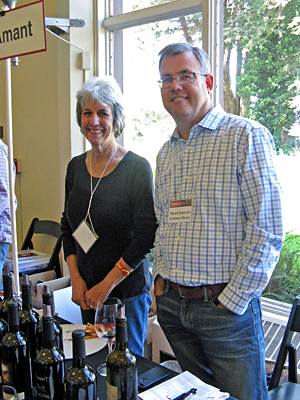 |
St. Amant 2014 “Miss Independent” Verdelho, Amador County. Made entirely in stainless steel. Very light straw color, this featured stone fruit and tropical fruit aromas with a touch of lemonpeel. Light and crisp, with a fresh finish, nice.
St. Amant 2012 Trousseau, Amador County. Pre-release. Lighter garnet-purple color, with lots of spice along with black cherry and sweet oak on the nose. Medium-light bodied with moderate tannins.
St. Amant 2013 “The Old Soldier” Touriga, Amador County. Medium-light purple color, showing ripe plum and spice, plus a hint of dried herbs. Medium-bodied, this was moderately rich on the palate with a fairly smooth finish.
St. Amant 2013 Souzão, Amador County. Aged in French and American oak, 25% new. Medium-light purple, aromas of black cherry, plum, spice, and black pepper. Medium weight with a lively mouthfeel and refined tannins, nice.
St. Amant 2013 “The Road Less Traveled” Tempranillo, Amador County. Aged in French and American oak, 25% new. Medium purple color, with plum, earth, smoke, dried herb, and a touch of vanilla/oak. Bigger and more structured on the palate, finishing with fine, chalky tannins, nice.
St. Amant 2012 Vintage Port, Amador County. From Touriga Nacional, Touriga Franca, Tinta Roriz, Tinta Cão, Souzão, and Bastardo, aged in neutral oak. Fairly dark purple, displaying upfront dark berry fruit, chocolate, and spice. Moderately sweet, this showed good structure and a long finish.
St. Amant NV Tawny Port, “Lot No. 8,” Amador County. Made from Bastardo, this wine was started in 2001 and has been aged in neutral oak – this is the most recent bottling, from March 2015. Medium-light garnet-purple, with intense aromas of plummy fruit, caramel, pecans, brown sugar, and spice. Fairly rich and sweet but with good acidity, this had a long finish, nice.
Comments: St. Amant was established in 1981 by the Spencer family, and Stuart Spencer (current TAPAS president) and his mother Barbara were on hand again to pour their wines. The fruit for their Iberian-variety wines comes from the family’s 43-acre vineyard in Jackson Valley, at the western edge of Amador County. The Trousseau (French name for Bastardo and currently the only name accepted by the TTB) will be St. Amant’s first non-dessert wine bottling of that variety. I was glad to be able to get back to their table to taste their dessert wines after missing them last year. The St. Amant wines have been solid and consistent over the years, and this was their strongest showing yet.
Tangent / Trenza Wineries
Tangent 2013 Albariño, Paragon Vineyard, Edna Valley. Light straw color, this showed apple and citrus aromas along with mildly floral notes. Lighter-bodied with moderate acidity and a smooth finish.
Tangent 2012 Grenache Blanc, Paragon Vineyard, Edna Valley. Very light straw color, with pear, herb, orangepeel and a touch of petrol on the nose. Medium-light weight and lively on the palate, with a crisp finish, nice.
Trenza 2011 “Tinto,” San Luis Obispo County. 59% Syrah, 30% Tempranillo, 8% Mourvèdre, 3% Malbec, sourced from Paso Robles, Edna Valley, and Arroyo Grande Valley, aged in 40% new French oak. Medium purple color, displaying earth, tobacco, ripe plum and darker fruit, and spice, with undertones of vanilla/oak. Moderately rich mouthfeel with firm tannins on the finish.
Comments: Tangent and Trenza are both labels of Niven Family Wine Estates and are based in Edna Valley. The family’s highly-regarded Paragon Vineyard provides much of the fruit for the wines. Tangent focuses on lighter, aromatic white wines, while Trenza produces “Blanco”, “Rosado”, and “Tinto” blends of Iberian and Rhône varieties. Veteran Central Coast vintner Christian Roguenant is the winemaker for both labels.
Tercero Wines
Tercero 2014 Albariño, C5 Vineyard, Santa Ynez Valley. Whole-cluster pressed, made in 67% stainless steel and 33% neutral oak. Medium-light straw color, with aromas of stone fruit, herbs, with a stony mineral note. Lighter-bodied with a bright mouthfeel and slightly chalky texture on the finish – could use a little more time to settle down but good potential.
Tercero 2013 Grenache Blanc, Santa Ynez Valley. About half each from Camp 4 and El Camino Real vineyards, made entirely in neutral oak. Light straw color, this featured apple, spice, with a touch of fresh herbs and a mild petrol component that’s characteristic of the variety. Medium-light weight on the palate, with lively acidity and a stony mineral note on the finish, nice.
Tercero 2014 Mourvèdre Rosé, Vogelzang Vineyard, Happy Canyon of Santa Barbara. 100% Mourvèdre, on the skins for about an hour, fermented in stainless steel and aged in neutral oak. Very light salmon-pink color, displaying herbs, spice, and earth aromas with strawberry and stone fruit in support. Medium-light bodied with a lively mouthfeel and just a touch of chalky tannin on the finish, nice.
Tercero 2010 Grenache, Larner Vineyard, Ballard Canton. Some whole-cluster fermentation, aged 34 months in neutral oak. Medium-light ruby color, with lots of upfront spice along with black cherry and plum, earth and dried herbs on the nose. Medium-bodied with good structure and moderate tannins.
Comments: Larry Schaffer started his Tercero label with the 2006 vintage while he was working for Fess Parker Winery – he’s focused on Tercero full-time since 2011. Larry uses stainless steel and neutral oak for fermenting and aging his white wines. With reds, he’s worked extensively with Grenache and increasingly with Mourvèdre, and he’s used more whole-cluster fermentations in recent years. I tasted many of the Tercero wines with Larry earlier in the year (“Verbiage Blanc,” Watch Hill Vineyard Grenache, and Mourvèdre were favorites) so I picked just a few bottlings at this tasting. This was Larry’s first time at TAPAS, and he presented a solid line-up of wines.
Thirty-Seven Winery
Thirty-Seven 2013 Albariño, Sonoma Coast. Made in stainless steel and a concrete egg. Light color, this had apple and pear fruit along with touches of earth and petrol. Medium-light bodied with a fairly smooth finish.
Comments: Proprietors Al Brayton and Elisa Correnti founded Thirty-Seven Winery in 2007 – they also run the Paradise View label. Their estate vineyard is near the intersection of highways 37 and 121 in the cool Petaluma Gap region, and the vines are from 8-12 years old. wines are made at the Lynmar facility by Shane Finley. Both Al and Elisa were behind their winery table at the tasting – they also had a Grenache on hand, but I skipped it since I had tasted it a few weeks earlier at the Rhone Rangers event, where I thought it was a standout.
Valley View Winery
Valley View 2011 Tempranillo, “Anna Maria,” Applegate Valley, Oregon. Medium-light purple, this showed lots of spice along with plum and black cherry fruit, plus a resiny oak component. Medium weight on the palate, finishing with moderate tannins.
Valley View 2011 Tempranillo, “Pioneer,” Rogue Valley, Oregon. Includes fruit from a warmer area in Bear Creek Valley. Medium purple color, displaying an earthier character than the previous wine, plus ripe plum, spice, and vanilla/oak aromas. Richer mouthfeel with a grippy tannic finish.
Valley View 2006 Tempranillo, “Anna Maria,” Applegate Valley, Oregon. Medium purple, this had earth, smoke, leather, and spice upfront with blueberry fruit in support. Medium-bodied and still retaining good structure, finishing with moderate tannins – this has developed nicely in the bottle.
Valley View 2009 Port, “Anna Maria,” Rogue Valley, Oregon. Mostly from Tempranillo. Medium-dark color, showing higher-toned raisiny fruit, spice, and vanilla/oak on the nose. Rich and moderately sweet, with a smooth finish.
Comments: Valley View Winery was established in 1972 by the Wisnovsky family, who continue to operate the winery. The focus is on Cabernet Sauvignon, Merlot, Viognier, Syrah, and Tempranillo from their estate vineyard in the Applegate Valley region of southern Oregon. The vineyard was first planted from 1972 to 1976, with some vines replanted or grafted to other varieties about ten years ago – the estate Tempranillo was grafted onto 35 year-old Cabernet vines. John Guerrero has been the Valley View winemaker since 1985.
Vara Wines
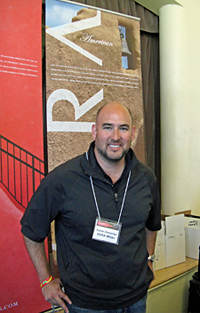 |
Vara 2014 Albariño, “Blanco Especial, Lot 104,” American. 77% Albariño, 14% Viognier, 9% Chardonnay. Light straw color, with fresh apple and herb aromas along with a floral note. Medium-light bodied with a bright mouthfeel and crisp finish, nice.
Vara 2013 “Blanco Especial, Lot 103,” American. 56% Albariño, 19% Viognier, 19% Marsanne, 6% Chardonnay. Slightly deeper color than the previous wine, showing more earth and herb notes with less upfront fruit. Medium weight with a richer texture and smooth finish.
Vara 2013 Tempranillo, “Tinto Especial, Lot 103,” American. 75% Tempranillo, 13% Garnacha, 9% Syrah, 3% Graciano. Medium-light purple color, this displayed earth, red fruits, spice, and a touch of pepper on the nose. Medium-bodied with a lively mouthfeel and moderate, chalky tannins.
Vara 2012 “Tinto Especial, Lot 102,” American. 60% Tempranillo, 28% Garnacha, 7% Syrah, 5% Monastrell. Medium purple, this was less fruit-forward, with earth, spice, pepper, and notes of smoke and leather along with black cherry and plum. Medium weight with good structure and chalky but refined tannins, nice.
Comments: Artist Xavier Zamarripa established the Vara label. It’s an interesting venture – based in Albuquerque, Vara produces wine from both Spain and New Mexico. While the estate vineyard plantings in New Mexico’s Rio Grande Valley are maturing, the American wines are being made with purchased fruit – the ones poured at TAPAS came from New Mexico vineyard sources at over 5,000-foot elevation. The wines are not actually vintage-dated on the labels, but Xavier pointed out that the lot number reveals the vintage. All the wines so far are “Blanco” and “Tinto” blends, though the most recent ones have been varietally-labeled – the wines were good and this could be a label worth watching.
Verdad Wine Cellars
Verdad 2014 Rosé, Central Coast. 71% Grenache, 29% Syrah, sourced from three vineyards. Very light pink-salmon color, with bright strawberry and herb aromas with a touch of spice. Lighter-bodied with vibrant acidity and a chalky texture
on the clean finish, nice.
Verdad 2013 Albariño, Sawyer Lindquist Vineyard, Edna Valley. Made in 75% stainless steel and 25% neutral oak. Light straw color, this featured pear and stone fruit, a touch of lemonpeel, and a floral note. Bright mouthfeel with a stony mineral element on the crisp finish, nice.
Verdad 2012 Graciano, Ibarra-Young Vineyard, Santa Ynez Valley. 90% Graciano, 10% Tempranillo, aged in three-year old puncheons. Medium-light purple, showing higher-toned red fruit aromas plus earth, spice, and fresh herbs. Medium-bodied with moderate tannins on the finish.
Verdad 2011 Tempranillo, Sawyer Lindquist Vineyard, Edna Valley. 100% Tempranillo, aged in 45% new French oak. Medium purple color, with complex aromas of tobacco/dried herbs, earth, smoke, spice, and plum and darker berry fruit. Medium weight and lively on the palate with good structure and firm tannins – nice now and should age well.
Verdad 2012 Tempranillo, Sawyer Lindquist Vineyard, Edna Valley. 92% Tempranillo, 8% Grenache, aged for two years in French and Hungarian oak. Medium color, this had a riper and darker fruit profile along with lots of spice, and a more noticeable oak component. Big and structured, finishing with grippier tannins – this will need more time in the cellar.
Verdad 2005 Tempranillo, Santa Ynez Valley. 75% Tempranillo, 15% Syrah, 10% Grenache. Medium purple color, with earth and leather notes along with spice, tobacco, and more subtle fruit in the background. Medium-bodied, this still had big, chewy tannins on the finish.
Comments: Louisa Sawyer Lindquist poured her Verdad wines, and once again she presented one of the strongest line-ups at the TAPAS tasting. Louisa and Verdad have been specializing in wines made from Iberian grape varieties since 2000. Sawyer Lindquist Vineyard in southern Edna Valley was planted in 2005 and is farmed biodynamically – its fruit has led to some outstanding wines in recent years.
|


